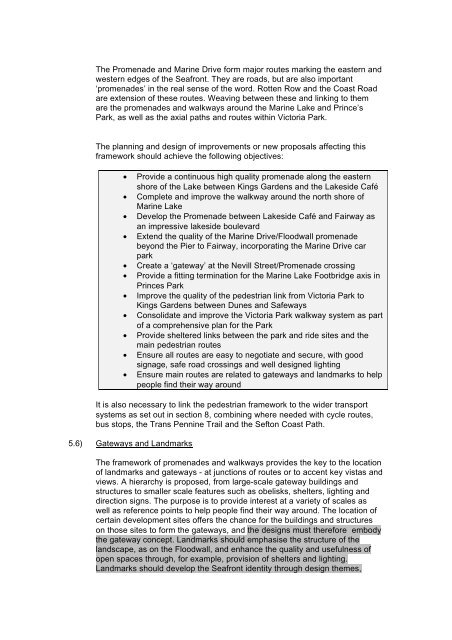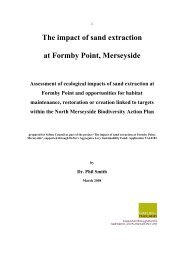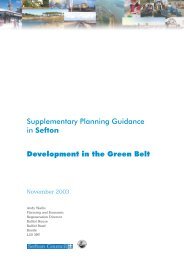PLI version Southport Seafront SPG - Sefton Council
PLI version Southport Seafront SPG - Sefton Council
PLI version Southport Seafront SPG - Sefton Council
Create successful ePaper yourself
Turn your PDF publications into a flip-book with our unique Google optimized e-Paper software.
The Promenade and Marine Drive form major routes marking the eastern and<br />
western edges of the <strong>Seafront</strong>. They are roads, but are also important<br />
‘promenades’ in the real sense of the word. Rotten Row and the Coast Road<br />
are extension of these routes. Weaving between these and linking to them<br />
are the promenades and walkways around the Marine Lake and Prince’s<br />
Park, as well as the axial paths and routes within Victoria Park.<br />
The planning and design of improvements or new proposals affecting this<br />
framework should achieve the following objectives:<br />
• Provide a continuous high quality promenade along the eastern<br />
shore of the Lake between Kings Gardens and the Lakeside Café<br />
• Complete and improve the walkway around the north shore of<br />
Marine Lake<br />
• Develop the Promenade between Lakeside Café and Fairway as<br />
an impressive lakeside boulevard<br />
• Extend the quality of the Marine Drive/Floodwall promenade<br />
beyond the Pier to Fairway, incorporating the Marine Drive car<br />
park<br />
• Create a ‘gateway’ at the Nevill Street/Promenade crossing<br />
• Provide a fitting termination for the Marine Lake Footbridge axis in<br />
Princes Park<br />
• Improve the quality of the pedestrian link from Victoria Park to<br />
Kings Gardens between Dunes and Safeways<br />
• Consolidate and improve the Victoria Park walkway system as part<br />
of a comprehensive plan for the Park<br />
• Provide sheltered links between the park and ride sites and the<br />
main pedestrian routes<br />
• Ensure all routes are easy to negotiate and secure, with good<br />
signage, safe road crossings and well designed lighting<br />
• Ensure main routes are related to gateways and landmarks to help<br />
people find their way around<br />
It is also necessary to link the pedestrian framework to the wider transport<br />
systems as set out in section 8, combining where needed with cycle routes,<br />
bus stops, the Trans Pennine Trail and the <strong>Sefton</strong> Coast Path.<br />
5.6) Gateways and Landmarks<br />
The framework of promenades and walkways provides the key to the location<br />
of landmarks and gateways - at junctions of routes or to accent key vistas and<br />
views. A hierarchy is proposed, from large-scale gateway buildings and<br />
structures to smaller scale features such as obelisks, shelters, lighting and<br />
direction signs. The purpose is to provide interest at a variety of scales as<br />
well as reference points to help people find their way around. The location of<br />
certain development sites offers the chance for the buildings and structures<br />
on those sites to form the gateways, and the designs must therefore embody<br />
the gateway concept. Landmarks should emphasise the structure of the<br />
landscape, as on the Floodwall, and enhance the quality and usefulness of<br />
open spaces through, for example, provision of shelters and lighting.<br />
Landmarks should develop the <strong>Seafront</strong> identity through design themes,















